Over the weekend April and myself rode with venerable local bike-camping non-profit Cycle Wild (of which I am part of) northwards from the safety of Portlandistan into the far-flung features of Clark County, Washington. The destination was Battle Ground Lake State Park, just three miles (5 km) outside of the city of Battle Ground.
April and I have been to this park a few times, and consider it to be a humble jewel: a small lake formed in a volcanic caldera, surrounded by trees, and only 25 miles (40 km) from the edge of Portland. The city of Battle Ground has all the services one would need for bike camping (save a bike shop, but the Fred Meyer hypermarket has basics like tubes) so one can stock up on supplies right before entering the park rather than hauling all their food from Portland. The park itself has a small campground divided into two distinct sections: the main loop which is dominated by RVs, and a walk-in site area. Naturally we gravitate towards the walk-ins, as there is less of a "yahoo" factor and the sites are more in nature without being too far from the main bathrooms.
And Battle Ground Lake also has four cabins available for rental. These cabins sleep up to five (full size futon for two, double bed for two, and single top bunk), have electric lighting/heating, and a table. The beds are a simple vinyl covered foam mat, but this means for bike camping we'd only need to bring bedding, food, camp kitchen stuff, and extra clothing. Cabins and yurts are pretty common at state park campgrounds in this part of the world. They are not expensive, especially when you fill them up ($30-65 a night depending where you are), comfortable, and highly desirable. It's next to impossible to get a yurt on the coast in the summer if you hadn't booked it six months in advance. But in the off-season, and especially at an off-the-beaten-path park like Battle Ground Lake, it's much easier. So Cycle Wild rented two cabins for this weekend.
Since out of all the folks in Cycle Wild I've ridden to the park the most, I was the one who routed the ride. And since I knew that the route was going to be relatively flat to slight upgrade, with a couple of short steep hills, and we would not be burdened with carrying a tent,* I decided that this adventure would be the appropriate place to test out the Raleigh Wayfarer for touring. My first Three Speed "Tour"!
So now you are asking: How did the Wayfarer do? For the most part, great! I was able to keep up a good pace and keep up with my derailleured brethren (or just April when we were alone). Lowering the gearing played a part: the low gear of 41 inches was able to handle all but one hill fine. (The hill that I couldn't handle was a short steep one of about 10% grade. If the road was quieter I might have tried "tacking" or switchbacking but since it had some traffic, I got off and walked. It added an extra minute.) And the high gear of 72 inches was a great cruising gear for the flats.
But you might have noticed I said for the most part. There was one issue, but it was a major one: my rear wheel. If you've been reading this blog long enough, you'll know that the rear wheel is the original steel rimmed 40 spoke job that came with the bike. The front wheel has been replaced with a more modern wheel (alloy rim and generator hub), but not the rear. I've been hoping to get as much life out of it as possible. But it's starting to go. I broke a spoke before the Cross-Con Tour, which Keith replaced when he was in town. Then a week and a half ago (and not long after Keith's spoke fix) another spoke went. So I had that fixed. I hoped that the wheel would hold out a bit, but no such luck. About four miles into the main ride departure point (the Expo Center MAX light rail stop in far north Portland)** another spoke went. Damn. The remarkable thing about 40 spoked steel wheels is that it takes a lot for them to get severely out of true. The wheel rotated fine. Yes there was a wobble, but it was not hitting brakes or frame. Wrap the broken spoke around another one and call it good.
If it was just a broken spoke, that would have been one thing. But no less than two miles later I noticed the rear wheel was handling like ass. Uh-oh. I pulled over to check, and sure enough, it was going flat. Going flat? But it has a thorn-resistant tube! It shouldn't do that? But it did. At this point, the rest of the group (eight folks) went ahead and April and I said we'd meet them at the park. (The group had maps and a cue sheet, so I wasn't too worried about them.) I removed wheel, tire, and tube, and sure enough there was a good sized hole.
I was in a bit of a pickle. The reason why I had a thorn-resistant tube on the rear, besides the difficulties of removing a Sturmey-Archer wheel, was because the spokes on the old wheel were poking upward through the rim. Without the beefy tube, I would be getting a slow leak due to a pinch flat every other day. I had a spare tube, but it was a normal tube. Could I patch a thorn-resistant tube? I don't know. It won't hurt to try.
So I went through the process and tested the tube with air before mounting. It held. Then I reseated tire, mounted wheel, and inflated to full pressure (65psi). It all seemed fine until I got to about 60psi, and then psssssssh. Fuck. Off comes the wheel, tire, tube. Turns out the leak was coming from the patch itself. There was a small "bubble" and then a hole. Was the patch defective? Or is it because the patch material is thinner than the rest of the tube, the patch couldn't hold the pressure, and popped? I'm thinking it was the latter. Lesson learned: don't try to patch a thorn-resistant tube. On went the normal tube. I crossed my fingers and hoped it would hold at least to the campground.
Two things that were noted during my tire tribulations: there was a lot of dirt stuck to the underside of the rear fender.*** So much so that when I scraped it off, where it fell would make a great planter:
Also April noticed that there was a big hole in her rear tire. It wasn't flat but the inner tube was starting to poke through the hole. So she put a boot on and called it good. She seems to have the worst luck with holes in tires. Thankfully the rear tire was a freebie.
Anyways, besides my mechanical escapades, the ride out was good. The weather report was iffy--20 to 30 percent chance o' rain depending on who you asked. But remarkably the rain held off for both Saturday and Sunday. It was mostly cloudy, though with sunbreaks and occasional glimpses of snow covered mountains like Mount Hood. The temperature hovered over 50F/10C. I basically got away with wearing a wool t-shirt/wool flannel/wool vest for my top the whole time.
The rest of the party greeted us when we arrived in camp. Besides the eight who started with us at Expo Center and who would be sleeping in the cabins (Matt P, Tomas, Audrey, Senior Ed, Erinne, Kirk, Ryan, Nolan), Theo and Asta rode out on their own and were tent camping across from our cabins. The evening was subdued, it wasn't the boisterous New Year's party.**** Some folks hung out by the fire, others played a spirited game of Apples to Apples. By 11pm, pretty much everyone had retired for the evening, including April and myself.
The next morning we mulled around camp a bit, then packed up and hit the road. I opted for a different routing to get back to Portland. The one going to Battle Ground Lake used the Interstate (I-5) Bridge that leads into the heart of Vancouver, Washington. On the return we used the Glenn Jackson (I-205) Bridge. I did this to get another "flavor" of Clark County, Wash. The route up was decent, about half sub-urban/half rural, but the rural section was still on moderate traffic roads. The return would be on low traffic roads until we hit the suburban sprawl of east Vancouver, which would be bike lanes/low-traffic neighborhood streets.
On the way back through town most of us stopped for lunch at Laurelwood Brewing, where I learned I had yet another rear flat. I let the main group go ahead while April waited for me to patch the tube. As I was worried would happen, the flat was apparently caused by those poking-through spokes.***** Thankfully the tire gave me no more troubles, and we made it back to the Portland side of the Columbia River (and the Cascades MAX stop) just as the sun was going down.
Overall it was a good adventure, despite the mechanical setbacks. Everyone seemed like they were having fun. But now I know that there ain't much life left on my rear wheel, and I'll need to get a new one built soon. Also, the tire is starting to show wear and there are multiple holes and gashes from glass and other debris, so I'll need a new tire as well. And a different rack, too. While the Dutch style rack is beefy, there is too much side to side sway when loaded with panniers. I could feel it when I ride, and because it mounts to the axle, I worry about what that could do to the axle and hub.
I'll be doing more Three Speed Touring Adventures, but not until these things are taken care of.
Links to the routes to Battle Ground Lake (Ride with GPS):
From Portland (Expo Center MAX)
From Battle Ground Lake
*And that my touring bike, the Surly Long Haul Trucker, needs work to make it rideable (repack headset)
**To note: April and I had rode about 10 miles (16 km) from our apartment to the start point, so we were already 15 miles in.
***Or if you must, mudguard.
****Meaning I didn't throw up.
*****I will note here that the rim has two liners and one strip of rim tape. So much for that.
April and I have been to this park a few times, and consider it to be a humble jewel: a small lake formed in a volcanic caldera, surrounded by trees, and only 25 miles (40 km) from the edge of Portland. The city of Battle Ground has all the services one would need for bike camping (save a bike shop, but the Fred Meyer hypermarket has basics like tubes) so one can stock up on supplies right before entering the park rather than hauling all their food from Portland. The park itself has a small campground divided into two distinct sections: the main loop which is dominated by RVs, and a walk-in site area. Naturally we gravitate towards the walk-ins, as there is less of a "yahoo" factor and the sites are more in nature without being too far from the main bathrooms.
And Battle Ground Lake also has four cabins available for rental. These cabins sleep up to five (full size futon for two, double bed for two, and single top bunk), have electric lighting/heating, and a table. The beds are a simple vinyl covered foam mat, but this means for bike camping we'd only need to bring bedding, food, camp kitchen stuff, and extra clothing. Cabins and yurts are pretty common at state park campgrounds in this part of the world. They are not expensive, especially when you fill them up ($30-65 a night depending where you are), comfortable, and highly desirable. It's next to impossible to get a yurt on the coast in the summer if you hadn't booked it six months in advance. But in the off-season, and especially at an off-the-beaten-path park like Battle Ground Lake, it's much easier. So Cycle Wild rented two cabins for this weekend.
Since out of all the folks in Cycle Wild I've ridden to the park the most, I was the one who routed the ride. And since I knew that the route was going to be relatively flat to slight upgrade, with a couple of short steep hills, and we would not be burdened with carrying a tent,* I decided that this adventure would be the appropriate place to test out the Raleigh Wayfarer for touring. My first Three Speed "Tour"!
So now you are asking: How did the Wayfarer do? For the most part, great! I was able to keep up a good pace and keep up with my derailleured brethren (or just April when we were alone). Lowering the gearing played a part: the low gear of 41 inches was able to handle all but one hill fine. (The hill that I couldn't handle was a short steep one of about 10% grade. If the road was quieter I might have tried "tacking" or switchbacking but since it had some traffic, I got off and walked. It added an extra minute.) And the high gear of 72 inches was a great cruising gear for the flats.
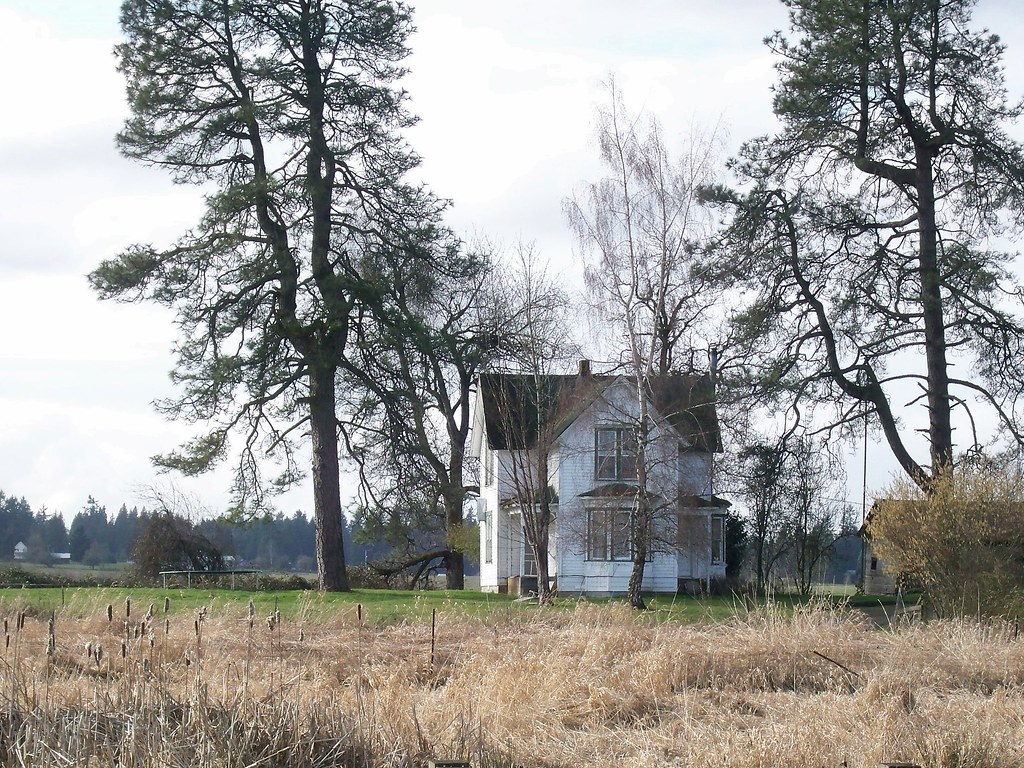 |
| Rural Clark County farmhouse |
But you might have noticed I said for the most part. There was one issue, but it was a major one: my rear wheel. If you've been reading this blog long enough, you'll know that the rear wheel is the original steel rimmed 40 spoke job that came with the bike. The front wheel has been replaced with a more modern wheel (alloy rim and generator hub), but not the rear. I've been hoping to get as much life out of it as possible. But it's starting to go. I broke a spoke before the Cross-Con Tour, which Keith replaced when he was in town. Then a week and a half ago (and not long after Keith's spoke fix) another spoke went. So I had that fixed. I hoped that the wheel would hold out a bit, but no such luck. About four miles into the main ride departure point (the Expo Center MAX light rail stop in far north Portland)** another spoke went. Damn. The remarkable thing about 40 spoked steel wheels is that it takes a lot for them to get severely out of true. The wheel rotated fine. Yes there was a wobble, but it was not hitting brakes or frame. Wrap the broken spoke around another one and call it good.
If it was just a broken spoke, that would have been one thing. But no less than two miles later I noticed the rear wheel was handling like ass. Uh-oh. I pulled over to check, and sure enough, it was going flat. Going flat? But it has a thorn-resistant tube! It shouldn't do that? But it did. At this point, the rest of the group (eight folks) went ahead and April and I said we'd meet them at the park. (The group had maps and a cue sheet, so I wasn't too worried about them.) I removed wheel, tire, and tube, and sure enough there was a good sized hole.
I was in a bit of a pickle. The reason why I had a thorn-resistant tube on the rear, besides the difficulties of removing a Sturmey-Archer wheel, was because the spokes on the old wheel were poking upward through the rim. Without the beefy tube, I would be getting a slow leak due to a pinch flat every other day. I had a spare tube, but it was a normal tube. Could I patch a thorn-resistant tube? I don't know. It won't hurt to try.
So I went through the process and tested the tube with air before mounting. It held. Then I reseated tire, mounted wheel, and inflated to full pressure (65psi). It all seemed fine until I got to about 60psi, and then psssssssh. Fuck. Off comes the wheel, tire, tube. Turns out the leak was coming from the patch itself. There was a small "bubble" and then a hole. Was the patch defective? Or is it because the patch material is thinner than the rest of the tube, the patch couldn't hold the pressure, and popped? I'm thinking it was the latter. Lesson learned: don't try to patch a thorn-resistant tube. On went the normal tube. I crossed my fingers and hoped it would hold at least to the campground.
Two things that were noted during my tire tribulations: there was a lot of dirt stuck to the underside of the rear fender.*** So much so that when I scraped it off, where it fell would make a great planter:
Also April noticed that there was a big hole in her rear tire. It wasn't flat but the inner tube was starting to poke through the hole. So she put a boot on and called it good. She seems to have the worst luck with holes in tires. Thankfully the rear tire was a freebie.
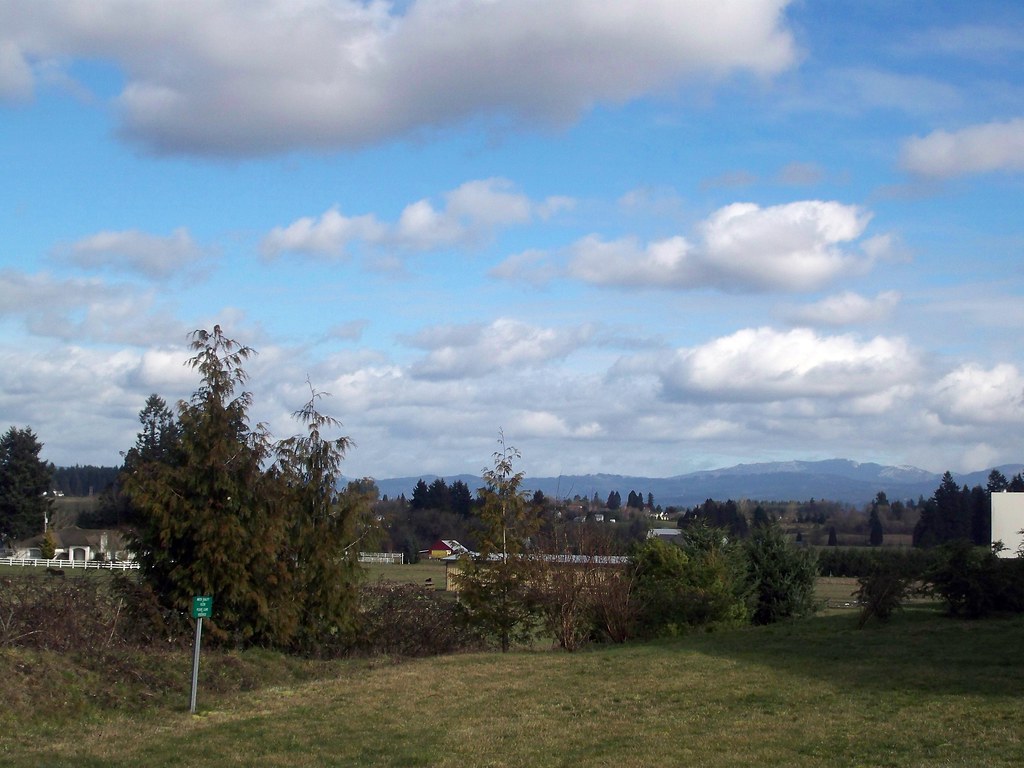 |
| Rural Clark County, looking east towards the Cascade Mountains |
Anyways, besides my mechanical escapades, the ride out was good. The weather report was iffy--20 to 30 percent chance o' rain depending on who you asked. But remarkably the rain held off for both Saturday and Sunday. It was mostly cloudy, though with sunbreaks and occasional glimpses of snow covered mountains like Mount Hood. The temperature hovered over 50F/10C. I basically got away with wearing a wool t-shirt/wool flannel/wool vest for my top the whole time.
The rest of the party greeted us when we arrived in camp. Besides the eight who started with us at Expo Center and who would be sleeping in the cabins (Matt P, Tomas, Audrey, Senior Ed, Erinne, Kirk, Ryan, Nolan), Theo and Asta rode out on their own and were tent camping across from our cabins. The evening was subdued, it wasn't the boisterous New Year's party.**** Some folks hung out by the fire, others played a spirited game of Apples to Apples. By 11pm, pretty much everyone had retired for the evening, including April and myself.
The next morning we mulled around camp a bit, then packed up and hit the road. I opted for a different routing to get back to Portland. The one going to Battle Ground Lake used the Interstate (I-5) Bridge that leads into the heart of Vancouver, Washington. On the return we used the Glenn Jackson (I-205) Bridge. I did this to get another "flavor" of Clark County, Wash. The route up was decent, about half sub-urban/half rural, but the rural section was still on moderate traffic roads. The return would be on low traffic roads until we hit the suburban sprawl of east Vancouver, which would be bike lanes/low-traffic neighborhood streets.
On the way back through town most of us stopped for lunch at Laurelwood Brewing, where I learned I had yet another rear flat. I let the main group go ahead while April waited for me to patch the tube. As I was worried would happen, the flat was apparently caused by those poking-through spokes.***** Thankfully the tire gave me no more troubles, and we made it back to the Portland side of the Columbia River (and the Cascades MAX stop) just as the sun was going down.
Overall it was a good adventure, despite the mechanical setbacks. Everyone seemed like they were having fun. But now I know that there ain't much life left on my rear wheel, and I'll need to get a new one built soon. Also, the tire is starting to show wear and there are multiple holes and gashes from glass and other debris, so I'll need a new tire as well. And a different rack, too. While the Dutch style rack is beefy, there is too much side to side sway when loaded with panniers. I could feel it when I ride, and because it mounts to the axle, I worry about what that could do to the axle and hub.
I'll be doing more Three Speed Touring Adventures, but not until these things are taken care of.
Links to the routes to Battle Ground Lake (Ride with GPS):
From Portland (Expo Center MAX)
From Battle Ground Lake
*And that my touring bike, the Surly Long Haul Trucker, needs work to make it rideable (repack headset)
**To note: April and I had rode about 10 miles (16 km) from our apartment to the start point, so we were already 15 miles in.
***Or if you must, mudguard.
****Meaning I didn't throw up.
*****I will note here that the rim has two liners and one strip of rim tape. So much for that.



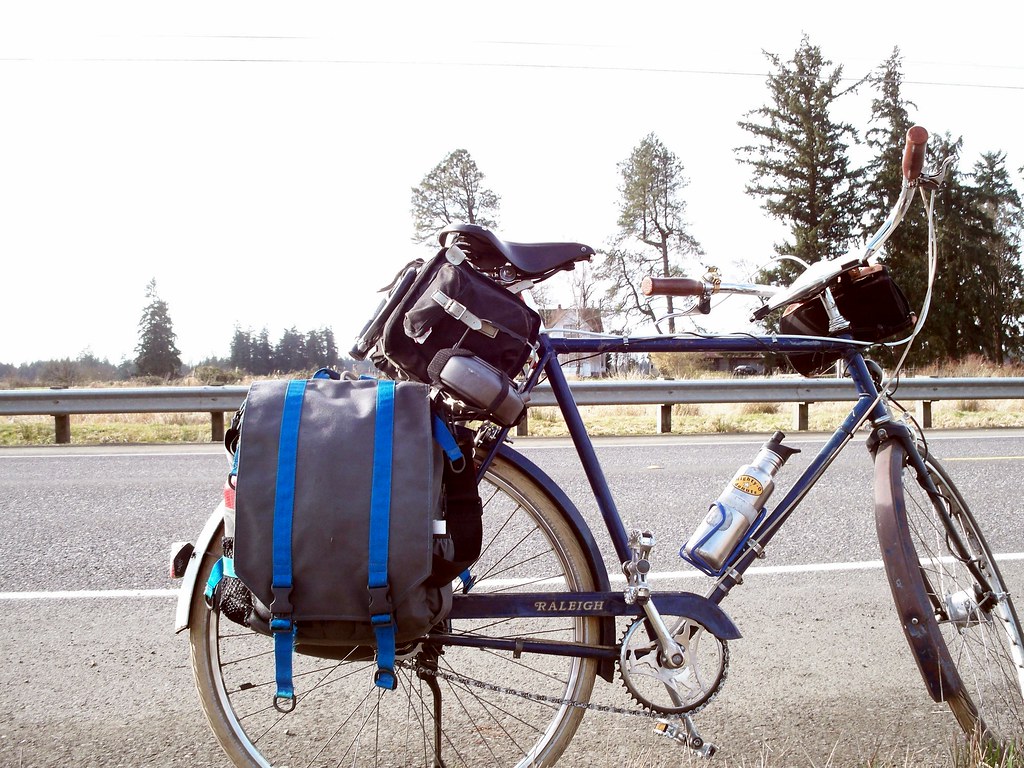
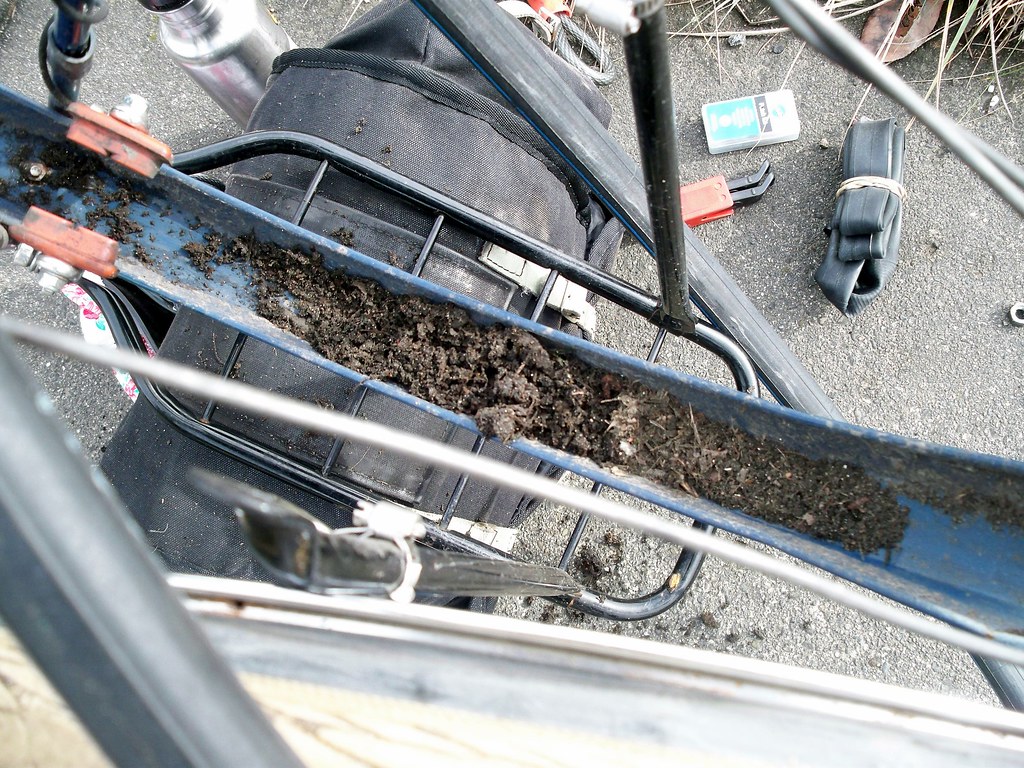
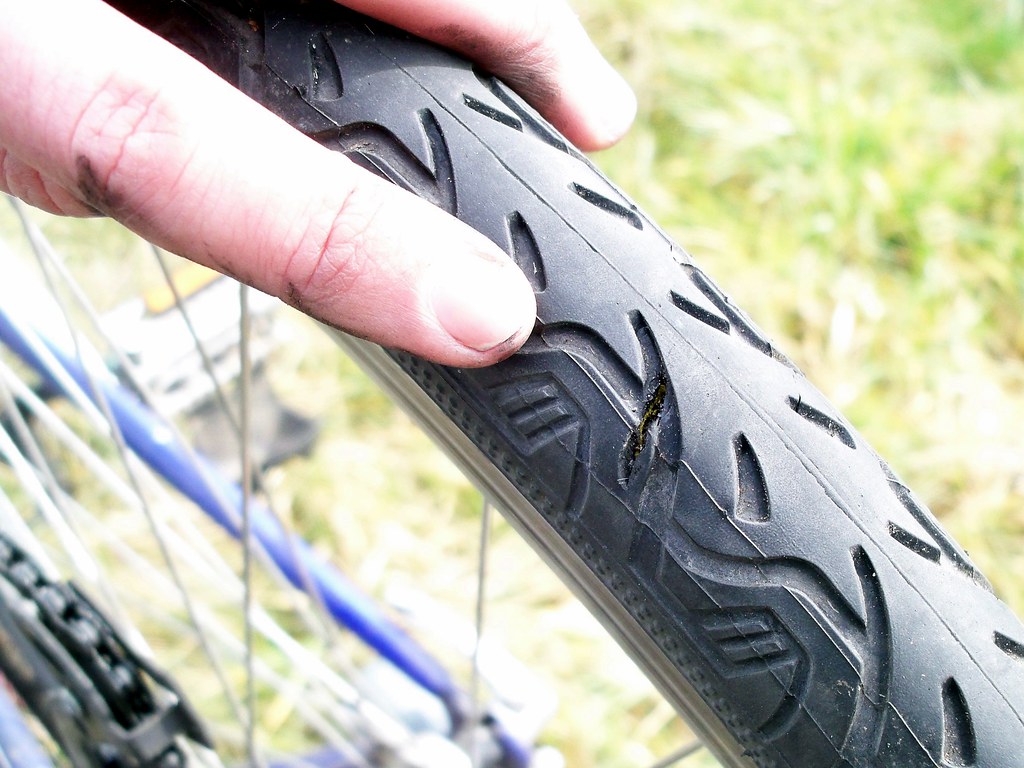


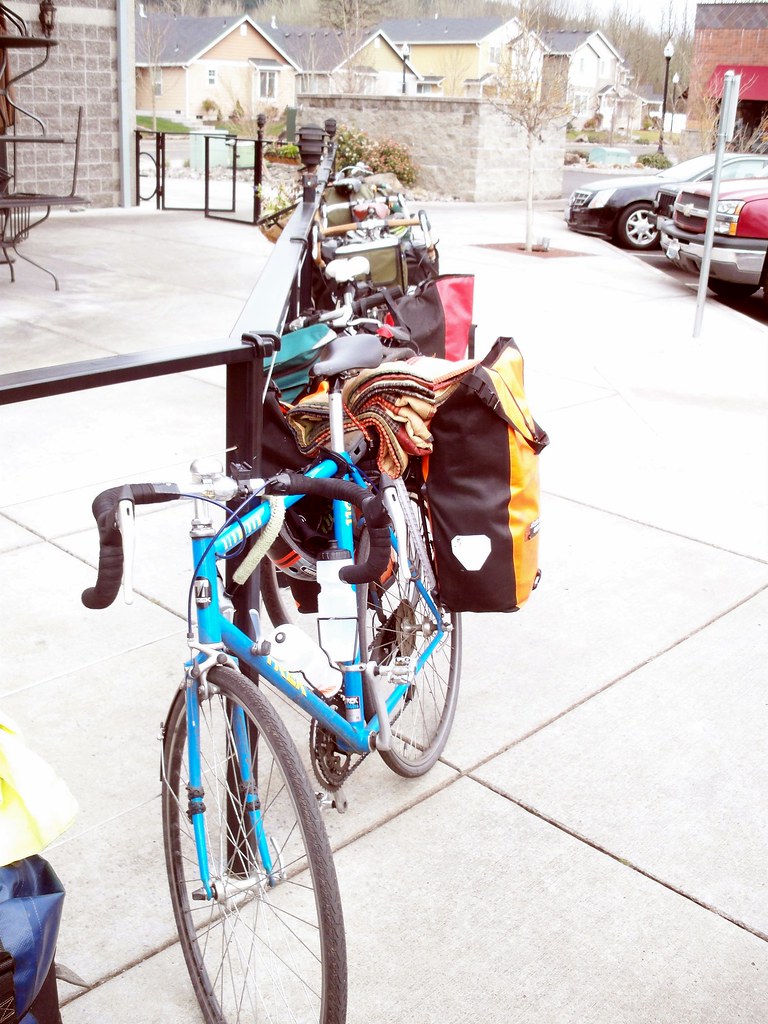
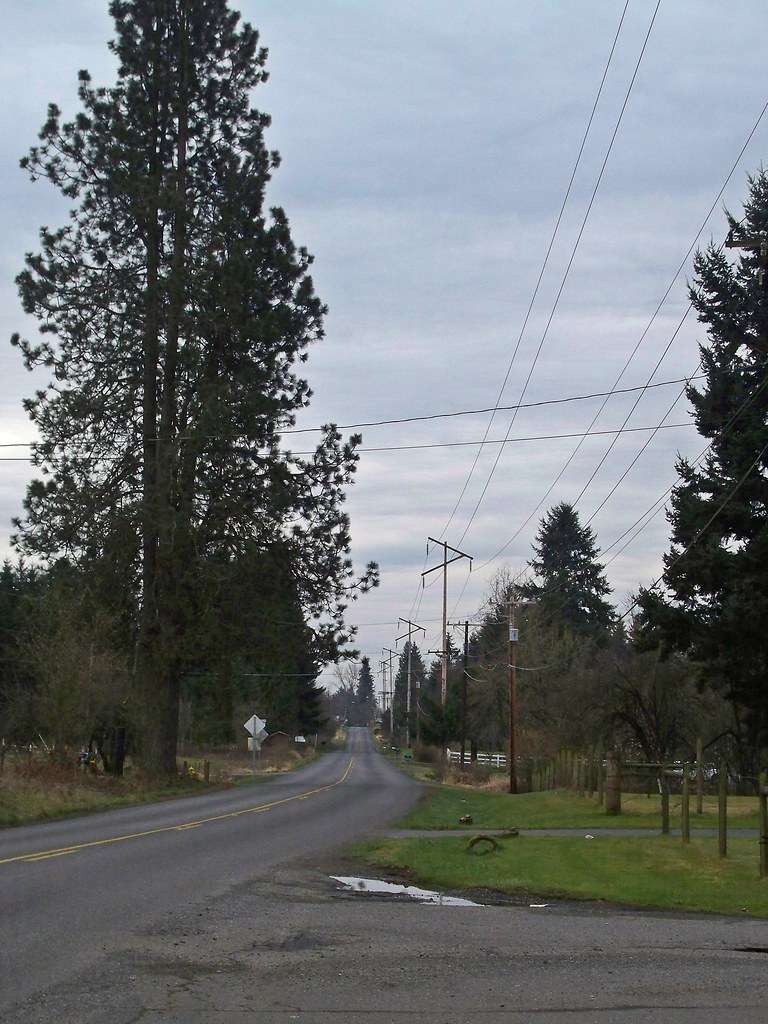
I like these bike packing adventures. Yours sounds wonderful and to have a cabin makes it even more fun, especially if it rains. I did one last year on my own and thought it was entirely worth it. I also want to try an overnight with my tank of a girly bike, something not too far because of its weight and our hills, but to see if it can be done.
ReplyDeleteIn my mind this morning, I shall be riding this trip, instead of my daily bike commute, omitting the spoke and tire difficulties, and imagining the bracing perfume of a campfire in the chill woods.
ReplyDeleteSounds like a fun trip! Thankfully you're wheel didn't fly apart on a fast downhill.
ReplyDeleteI have one spoke busted on my ~40 year old Norco rear rim, and the rim is hardly deflected, so I'm just leaving it for now. Although I don't ride it much (since the front brake is almost useless).
Sounds awesome,enjoyed reading about your,trip,my friend! Can't wait to doa similar one myself this year :)
ReplyDeleteThe Disabled Cyclist
So freaking cool. I will definitely be checking out some Cycle Wild fun this spring. And speaking of freaking cool, got your package in the mail -- thanks!
ReplyDeleteLooks like a lovely trip, although it's always a shame when mechanical problems mean that you're worrying about the bike rather than fully experiencing the journey.
ReplyDeleteWhat are your plans with the wheel? On the older wheels I've worked on, the rims and hubs are usually fine, but the spokes have become brittle after years of being used at the wrong tension (and perhaps the metalwork of the time of manufacture was poorer). Rebuilding the wheel would be a good opportunity to replace the rim with an aluminium one to improve braking, but I'm not sure how available 590mm 40 hole aluminium rims are, and I know you're quite attached to the original hub. Considering the back wheel doesn't contribute much to braking anyway, you might be best off having the original hub and rim rebuilt with some lovely modern spokes and nipples. Having the old spokes as a reference for the necessary spoke length, combined with the strength of steel rims means that the re-build should be pretty straight forward. Over here it would only cost about £10 in parts, I bet it'd be even less in the US due to generally lower sales taxes etc.
Dr. C--Good question! The easiest thing to do would be just rebuild the wheel with current hub and rim but new spokes. But I think I'll get a new rim while I'm at it, since I have this opportunity. Hopefully we can find a 40 spoke CR 18 rim (they say they exist.) If we can't, we'll go with a 36 spoke and use a different AW hub shell, one with 36 spoke holes, then plop the extant AW hub internals in there. The internals are from a 1954 hub, might as well keep it going as long as possible!
Delete